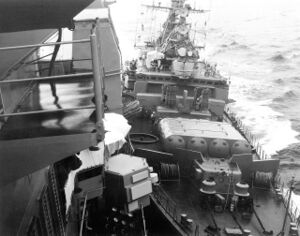Vasilin Sea crisis
This article is incomplete because it is pending further input from participants, or it is a work-in-progress by one author. Please comment on this article's talk page to share your input, comments and questions. Note: To contribute to this article, you may need to seek help from the author(s) of this page. |
| Vasilin Sea crisis | |||||||
|---|---|---|---|---|---|---|---|
 Ship bumping into ship | |||||||
| |||||||
| Belligerents | |||||||
|
|
| ||||||
| Commanders and leaders | |||||||
|
|
| ||||||
The Vasilin Sea crisis, also known as the Sateroc crisis was a period of heightened tensions between the Puoc regime in Sateroc and its neighbors in the Vasilin Sea, especially Saroq, which Sateroc invaded three times throughout the crisis. However, other important state actors, such as Vœyetska and North Kandson played an important role throughout the crisis as they opposed the Puoc regime. The crisis at sea was characterized by repeated naval confrontations, and although there was no direct combat, both sides took steps to indirectly combat the other.
Background
In 1953, the Saterocian monarchy was overthrown in a revolution due to unpopular doings by the monarchy, specifically King Mirnsec V, who suspended parliament following an assassination attempt which wounded Mirnsec. After the monarchy was overthrown, and the royal family was murdered, conservative and rural civilians loyal to the monarchy rose up against the new republic and began a 7-month long civil war which saw the deaths of at least 84,000 Saterocians. However, in the end, the republican government won after a final offensive into Cascutia which saw the final loyalists surrender. However, President Goen conflicted with his generals over which direction he wanted to take Sateroc, and less than a month after the end of the civil war, these generals formed the Unitary Salvation Forces and overthrew the republic, executing President Goen in the process.
At the helm of the USF was Arnaud Puoc, who was an older general who commanded portions of the republican army during the Saterocian civil war. He quickly garnered support by pushing nationalist sentiments across the country, including a rapid militarization by conscripting a lot of Sateroc's able-bodied men into the military, along with constructing modernized equipment. Puoc was also anti-western, as many western countries supported the monarchy, and condemned Puoc's take over, many of which also refused to recognize Puoc as "leader-general" of Sateroc. Because of this, Sateroc was surrounded by countries hostile to itself, further intensifying the rapid military build-up. Vœyetska in particular was repeatedly threatened over anti-monarchist sentiments before the crisis officially began.
Saroq, a nation which had seceded in the midst of an internal crisis in Sateroc, received countless threats from Puoc's government in the years following the takeover of power. Puoc had plans to invade the country and annex it once again, which caused an even more tense situation between him and Sateroc's neighbors, along with a majority of the international community which opposed Puoc. In the months leading up to 8 September 1967, Sateroc's fresh naval forces were deployed in the outer parts of its territorial waters in preparation for the first invasion of Saroq.